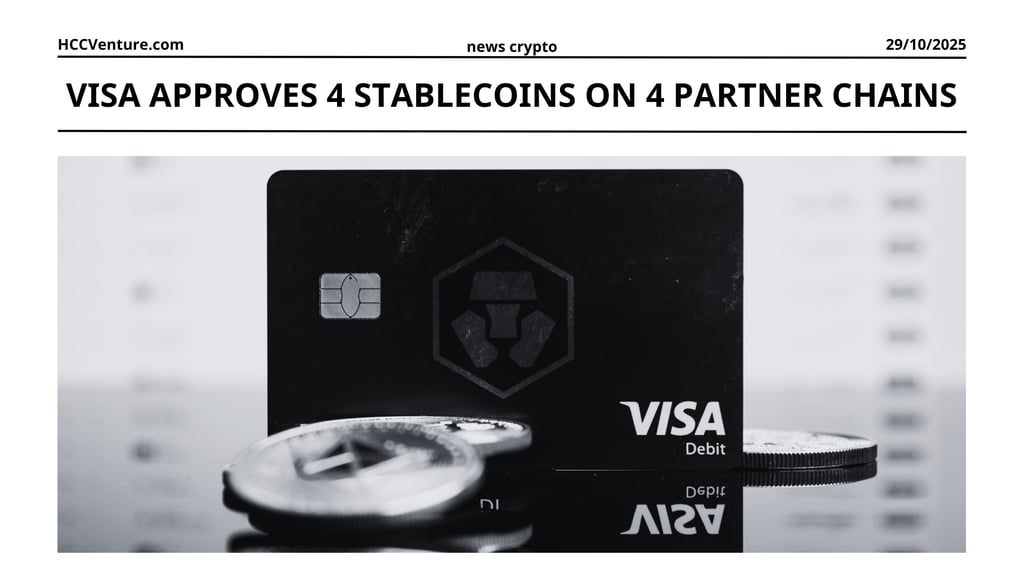Visa Approves 4 Stablecoins on 4 Partner Chains
Visa has announced a comprehensive payment plan that supports four major stablecoins on four separate blockchains, enabling seamless conversion to more than 25 fiat currencies across its vast network.
10/29/20252 min read


Stablecoins on Sovereign chains
Visa's " Stablecoin Payments Network " integrates four leading stablecoins, each anchored to a blockchain optimized for speed, cost, or scale, with instant fiat conversions to more than 25 currencies ( USD, EUR, JPY, GBP, AUD, etc. ) via Visa Direct and Visa B2B Connect. This multi-chain model—unlike single network silos—ensures redundancy and interoperability, with Circle's Cross-Chain Transfer Protocol (CCTP) supporting atomic swaps. Major Stablecoins included:
USDC on Ethereum: $35 billion giant Circle, long-time Visa partner, handles institutional forex and treasury transactions; Ethereum securities match enterprise TAM of over $100 billion.
PYUSD on Solana: PayPal's $500M Issuer Leverages Solana's 1,500 TPS for Retail Remittances; Sub-1-Second Payments Targeting $800B Corridors Like U.S.-Mexico
USDT on Tron: Tether's $120 billion giant, Tron's low-fee backbone (under $0.01/transaction) excels in high-volume emerging markets; $50 billion Asian inflow.
PAX on Polygon: Paxos' $100M Managed Issuer Extends Polygon's L2 for E-Commerce; 10,000 TPS Enables Micropayments in $1.5 Trillion Global Retail.
During its Q4 2025 earnings call, Visa revealed that it plans to support four additional stablecoins, each operating on a different blockchain, including two fiat currency models and convertible into more than 25 traditional fiat currencies.
Why is this important to Visa?
Visa’s move marks a significant shift: stablecoins are no longer a niche cryptocurrency tool but are being integrated into mainstream payment infrastructure. By supporting multiple chains and stablecoins, Visa is preparing to expand global transaction volume for cryptocurrencies. This effort complements cross-border payments and card payments, where latency, exchange rate differences, and fee transparency remain persistent issues.
By using four blockchains instead of one, Visa avoids network congestion, downtime, and chain-specific risks. It also gives issuers/merchants flexibility based on geography, costs, and user base, allowing different chains to perform better. This architecture signals a future where payments are “blockchain-agnostic” and stablecoins can operate across multiple chains and interact with each other.
The fact that supported stablecoins can be converted into more than 25 fiat currencies underscores Visa’s global payment ambitions. This means users can pay with stablecoins and issuers can receive payments in their local currency — Visa handles the conversion behind the scenes. The combination of on-chain tokens and off-chain fiat bridges is key to adoption in regions where cryptocurrencies are not yet widespread.
Disclaimer: The information presented in this article is the author's personal opinion in the cryptocurrency field. It is not intended to be financial or investment advice. Any investment decision should be based on careful consideration of your personal portfolio and risk tolerance. The views expressed in this article do not represent the official position of the platform. We recommend that readers conduct their own research and consult with a professional before making any investment decisions.
Explore HCCVenture group
HCCVenture © 2023. All rights reserved.


Connect with us
Popular content
Contact to us
E-mail : holdcoincventure_contact@hccventure.com
Register : https://linktr.ee/holdcoincventure
Disclaimer: The information on this website is for informational purposes only and should not be considered investment advice. We are not responsible for any risks or losses arising from investment decisions based on the content here.


TERMS AND CONDITIONS • CUSTOMER PROTECTION POLICY
ANALYTICAL AND NEWS CONTENT IS COMPILED AND PROVIDED BY EXPERTS IN THE FIELD OF DIGITAL FINANCE AND BLOCKCHAIN BELONGING TO HCCVENTURE ORGANIZATION, INCLUDING OWNERSHIP OF THE CONTENT.
RESPONSIBLE FOR MANAGING ALL CONTENT AND ANALYSIS: HCCVENTURE FOUNDER - TRUONG MINH HUY
Read warnings about scams and phishing emails — REPORT A PROBLEM WITH OUR SITE.
